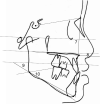Skeletal changes of maxillary protraction without rapid maxillary expansion
- PMID: 20482355
- PMCID: PMC8966461
- DOI: 10.2319/091609-521.1
Skeletal changes of maxillary protraction without rapid maxillary expansion
Abstract
Objective: To determine potential differences in treatment efficiencies of face mask therapy without rapid maxillary expansion (RME) at different early dental stages.
Materials and methods: Forty-nine Class III children who were treated with a face mask without RME were divided into two groups according to their pretreatment dental stage. The primary dentition treatment group consisted of 26 subjects and the mixed dentition treatment group consisted of 23 subjects. Lateral cephalograms before treatment (T0), at the end of treatment (T1), and at least 1 year after the end of treatment (T2) were calculated and analyzed. Fourteen cephalometric variables were evaluated by t-test to identify any significant differences in skeletal changes between the two groups during T1-T0, T2-T1, and T2-T0.
Results: The primary dentition group showed not only a greater response to maxillary protraction without RME than did the mixed dentition group during T1-T0, but also a greater relapse tendency during T2-T1. As a result, no significant differences were noted between the two groups in the treatment effects of face masks without RME over the time period T2-T0.
Conclusion: This study suggests that face mask therapy without RME may be postponed to the early to mid mixed dentition period because the therapy induces similar skeletal changes when initiated at primary or mixed dentition.
Figures




Similar articles
-
Is maxillary protraction the earlier the better? A retrospective study on early orthodontic treatment of Class III malocclusion with maxillary deficiency.J Clin Pediatr Dent. 2024 Nov;48(6):133-143. doi: 10.22514/jocpd.2024.133. Epub 2024 Nov 3. J Clin Pediatr Dent. 2024. PMID: 39543890
-
Early treatment of the Class III malocclusion with rapid maxillary expansion and maxillary protraction.Am J Orthod Dentofacial Orthop. 1998 Feb;113(2):196-203. doi: 10.1016/s0889-5406(98)70292-6. Am J Orthod Dentofacial Orthop. 1998. PMID: 9484211
-
Soft tissue and dentoskeletal profile changes associated with maxillary expansion and protraction headgear treatment.Am J Orthod Dentofacial Orthop. 1996 Jan;109(1):38-49. doi: 10.1016/s0889-5406(96)70161-0. Am J Orthod Dentofacial Orthop. 1996. PMID: 8540481
-
Maxillary protraction for early orthopedic correction of skeletal Class III malocclusion.Pediatr Dent. 1993 May-Jun;15(3):203-7. Pediatr Dent. 1993. PMID: 8378159 Review.
-
Maxillary protraction at early ages. The revolution of new bone anchorage appliances.J Clin Pediatr Dent. 2012 Winter;37(2):219-29. doi: 10.17796/jcpd.37.2.q0k770403v443053. J Clin Pediatr Dent. 2012. PMID: 23534334 Review.
Cited by
-
Displacements prediction from 3D finite element model of maxillary protraction with and without rapid maxillary expansion in a patient with unilateral cleft palate and alveolus.Biomed Eng Online. 2015 Aug 19;14:80. doi: 10.1186/s12938-015-0074-9. Biomed Eng Online. 2015. PMID: 26285822 Free PMC article.
-
The Effects of Maxillary Protraction with or without Rapid Maxillary Expansion and Age Factors in Treating Class III Malocclusion: A Meta-Analysis.PLoS One. 2015 Jun 11;10(6):e0130096. doi: 10.1371/journal.pone.0130096. eCollection 2015. PLoS One. 2015. PMID: 26068221 Free PMC article.
-
Effectiveness of maxillary protraction using facemask with or without maxillary expansion: a systematic review and meta-analysis.Clin Oral Investig. 2015 Jul;19(6):1181-92. doi: 10.1007/s00784-015-1478-4. Epub 2015 May 19. Clin Oral Investig. 2015. PMID: 25982454
-
Comparison of skeletal anchored facemask and tooth-borne facemask according to vertical skeletal pattern and growth stage.Angle Orthod. 2014 Jul;84(4):628-33. doi: 10.2319/060313-421.1. Epub 2013 Nov 25. Angle Orthod. 2014. PMID: 24274955 Free PMC article.
-
Comparison of short-term effects between face mask and skeletal anchorage therapy with intermaxillary elastics in patients with maxillary retrognathia.Eur J Orthod. 2016 Jun;38(3):313-23. doi: 10.1093/ejo/cjv053. Epub 2015 Jul 27. Eur J Orthod. 2016. PMID: 26219549 Free PMC article. Clinical Trial.
References
-
- Proffit W. R, Fields H. W., Jr . Contemporary Orthodontics. St Louis, Mo: Mosby; 2000. pp. 270–518.
-
- Yang W. S. The study on the orthodontic patients who visited department of orthodontics, Seoul National University Hospital during last 10 years (1985–1994) Korean J Orthod. 1995;25:497–509.
-
- Deguchi T, Kuroda T, Minoshima Y, Graber T. M. Craniofacial features of patients with Class III abnormalities: growth-related changes and effects of short-term and long-term chin cup therapy. Am J Orthod Dentofacial Orthop. 2002;121:84–92. - PubMed
-
- Sugawara J, Asano T, Endo N, Mitani H. Long-term effects of chincup therapy on skeletal profile in mandibular prognathism. Am J Orthod Dentofacial Orthop. 1990;98:127–133. - PubMed
-
- Sugawara J, Mitani H. Facial growth of skeletal Class III malocclusion and the effects, limitations, and long-term dentofacial adaptations to chin cup therapy. Semin Orthod. 1997;3:244–254. - PubMed
Publication types
MeSH terms
LinkOut - more resources
Full Text Sources
Research Materials

